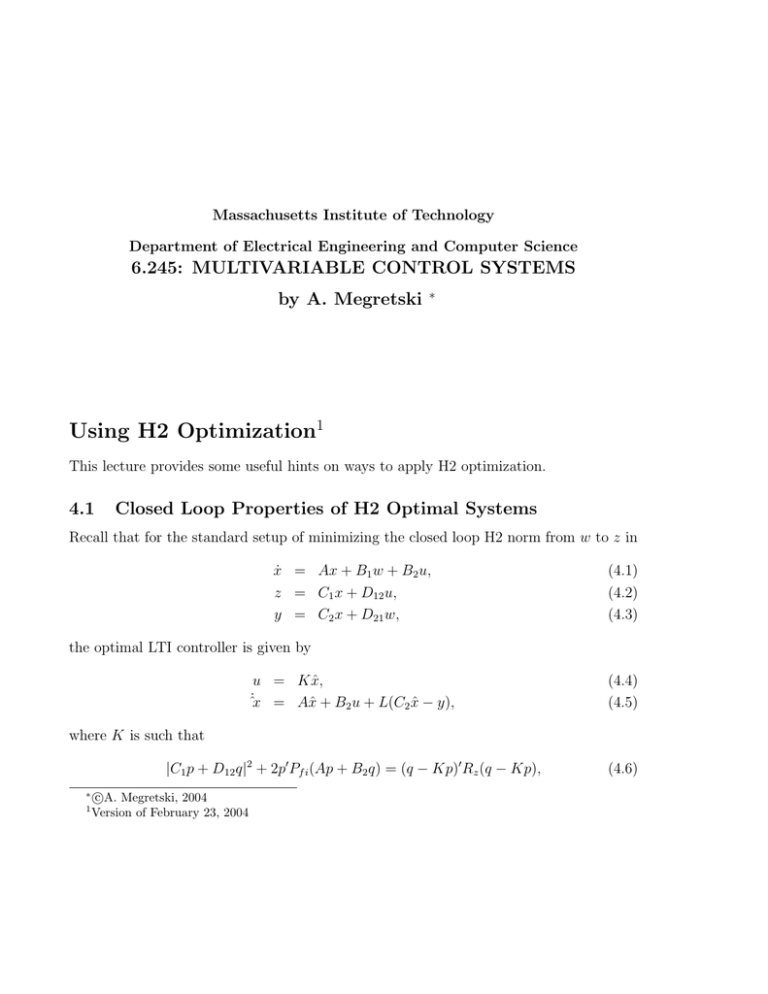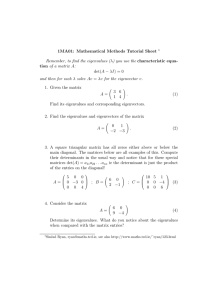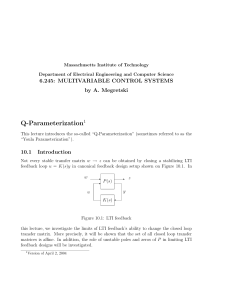Massachusetts Institute of Technology
advertisement

Massachusetts Institute of Technology
Department of Electrical Engineering and Computer Science
6.245: MULTIVARIABLE CONTROL SYSTEMS
by A. Megretski
�
Using H2 Optimization1
This lecture provides some useful hints on ways to apply H2 optimization.
4.1
Closed Loop Properties of H2 Optimal Systems
Recall that for the standard setup of minimizing the closed loop H2 norm from w to z in
ẋ = Ax + B1 w + B2 u,
z = C1 x + D12 u,
y = C2 x + D21 w,
(4.1)
(4.2)
(4.3)
the optimal LTI controller is given by
u = K x̂,
x + B2 u + L(C2 xˆ − y),
ˆ˙x = Aˆ
(4.4)
(4.5)
|C1 p + D12 q|2 + 2p� Pf i (Ap + B2 q) = (q − Kp)� Rz (q − Kp),
(4.6)
where K is such that
�
1
c
Megretski, 2004
A.
Version of February 23, 2004
2
�
A + B2 K is a Hurwitz matrix, Rz = D12
D12 , and Pf i = Pf� i � 0 is a symmetric matrix.
Similarly, L is such that
�
|B1� p + D21
q|2 + 2p� Pse (A� p + C2� q) = (q − L� p)� Ry (q − L� p),
(4.7)
�
�
where A + LC2 is a Hurwitz matrix, Ry = D21 D21
, and Pse = Pse
� 0 is a symmetric
matrix.
In this section, we investigate the closed loop properties of H2 optimal feedback sys­
tems which can be derived from these characterizations.
4.1.1
Closed Loop Poles
The closed loop system dynamics can be written in terms of the new states e = x − x̂ and
x̂:
ė = (A + LC2 )e + (B1 + LD21 )w,
˙ˆx = (A + B2 K)x̂ − LC2 e − LD21 w.
(4.8)
(4.9)
In particular, this implies that the closed loop poles are eigenvalues of A + B2 K and
A + LC2 .
It turns out that identities (4.6), (4.7) can be used to get some insight into locations
of these poles. Indeed, eigenvalues of A + B2 K are zeros of
�u (s) = I − K(sI − A)−1 B2 ,
because
det(sI − A − B2 K) = det(sI − A) det(I − B2 K(sI − A)−1 ) = det(sI − A)−1 det(�u (s)),
where we have use the fact that
det(I + ab) = det(I + ba)
for every pair of matrices a, b of compatible dimensions (and the identity matrices on both
sides may have different dimensions). Similarly, eigenvalues of A + LC2 are zeros of
�y (s) = I − L� (sI − A� )−1 C2� .
On the other hand, noting that (4.6) will hold for complex vectors p, q, as long as it is
modified to a Hermitian norm identity
|C1 p + D12 q|2 + 2Re{p� Pf i (Ap + B2 q)} = (q − Kp)� Rz (q − Kp),
(4.10)
3
where
�
denotes Hermitian conjugation, and substituting
p = (j�I − A)−1 B2 q
yields the identity
P12 (−s)T P12 (s) = �u (−s)T Rz �u (s)
(4.11)
for all s = j� on the imaginary axis (except, strictly speaking, possible eigenvalues of
A). Since(4.11) is an identity between rational functions, its validity on the imaginary
axis implies its validity for all s. In particular, zeros of det(� u (s)) (i.e. the eigenvalues
of A + B2 K) are the stable zeros of det{P12 (−s)T P12 (s)}.
A similar derivation shows that zeros of det(�y (s)) (i.e. the eigenvalues of A + LC2 )
are the stable zeros of det{P21 (s)P21 (−s)T }.
For example, in a special case when the optimization setup is defined by a SISO plant
P0 (s) = C(sI − A)−1 B,
where (A, B) is controllable and (C, A) is observable, according to
ẋ
z1
z2
y
=
=
=
=
Ax + B(w1 + u),
Cx,
rz u,
Cx + ry w2 ,
(4.12)
(4.13)
(4.14)
(4.15)
where w = [w1 ; w2 ] is the total disturbance, and rz , ry are positive coefficients, the closed
loop poles of H2 optimal feedback system are the stable zeros of
�u (s) = rz2 + P0 (s)P0 (−s)
and
�y (s) = ry2 + P0 (s)P0 (−s).
In particular, one can now apply the standard properties of the root locus to predict the
asymptotic behavior of the poles as rz and ry converge to zero or infinity. For example,
when rz is small, some eigenvalues of A + B2 K are close to the stable zeros of P0 (s) and
to the mirror (with respect to the imaginary axis) images of unstable zeros of P 0 (s), with
the rest of eigenvalues approaching infinity. Similarly, when rz is large, the eigenvalues of
A+BK2 approximate stable eigenvalues of A and the mirror images of unstable eigenvalues
of A.
4
4.1.2
Closed Loop Stability Robustness
Is stability of the closed loop be preserved when the optimal gains K, L are replaced by
some other gains? Optimal H2 controllers frequently have plenty of robustness this way,
though this usually does not transform into real robustness (which is caused by errors in
modeling the outside world, not the controller’s coefficients).
Consider again the special feedback optimization setup (4.12)-(4.15). The correspond­
ing solutions Pf i and Pse of Riccati equations satisfy
Pf i (A + BK) + (A + BK)� Pf i = −C � C − rz2 K � K, B � Pf i = −rz2 K,
(4.16)
Pse (A� + L� C � ) + (A� + L� C � )Pse = −BB � − ry2 LL� , C2 Pse = −ry2 L� ,
(4.17)
and hence both are positive definite. Moreover (4.16) implies that
Pf i (A + BzK) + (A + BzK)� Pf i = −C � C − rz2 K � (1 + 2Re(z))K
is negative definite for every complex number z with Re(z) > −0.5. Therefore, all eigen­
values of A + BzK have negative real part for Re(z) > −0.5. Similarly, A + LzC 2 is a
Hurwitz matrix for Re(z) > −0.5.
This observation was originally used to claim that the optimal H2 feedback has a 50
percent gain margin and a 60 percent phase margin. In reality, this only holds for the full
information or state estimation problems. Indeed, K enters the formula for the output
feedback controller in two places: in defining the control output u = K x̂, and in defining
the state observer dynamics
ˆ˙x = (A + B2 K + LC2 )x̂ − Ly.
While an unknown controller gain uncertainty can be combined with K in the first ap­
pearance, in most situations one cannot do the same in the second appearance. The
situation with the observer gain is similar. All the controversy around the originally
claimed “robustness” of optimal H2 control has served as a catalyst for developing HInfinity optimization and mu-synthesis.


![MA1S12 (Timoney) Tutorial sheet 7b [March 10–14, 2014] Name: Solutions](http://s2.studylib.net/store/data/011008030_1-c04da3e7c2d74dfcf07e513d17d7896f-300x300.png)





